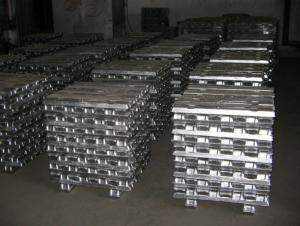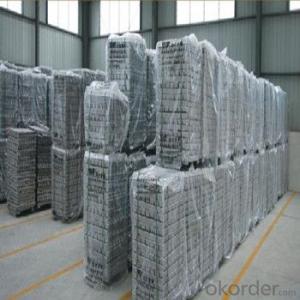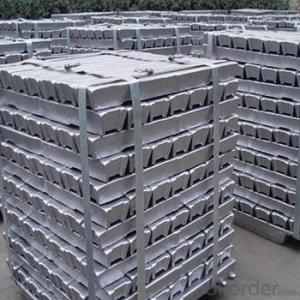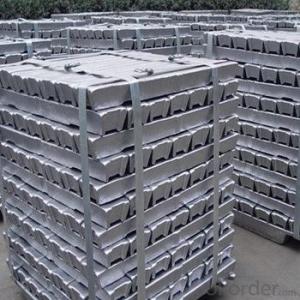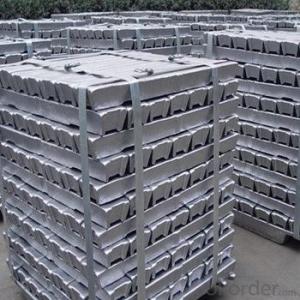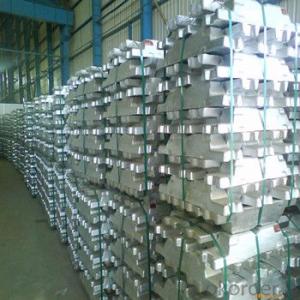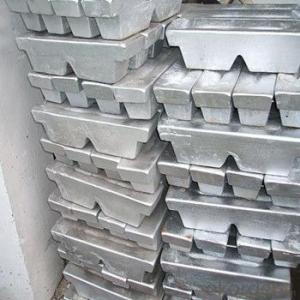Aluminum Pig/Ingot With Good Quality And Wholesale Price
- Loading Port:
- China main port
- Payment Terms:
- TT OR LC
- Min Order Qty:
- 1000 m.t.
- Supply Capability:
- 100000 m.t./month
OKorder Service Pledge
OKorder Financial Service
You Might Also Like
Pure Aluminum Pig/Ingot Used for Industry
1.Structure of Aluminum Pig/Ingot
A material that has been cast into a shape in order to be transported and processed easier than in an unprocessed form. An ingot is typically rectangular in shape, which allows it to be stacked. Ingots are most commonly associated with metals, with ingots of gold held in the vaults of banks and brokerages being popular images.
Aluminum Ingot is with the AL as the main chemical composition.Aluminum Ingot is used for industry,such as automobile,pinning and weaving,electron broadly and so on. Aluminum Ingot has the following advantages: easy control and operation, fast melting.
2.Main Features of the Aluminum Pig/Ingot
•High Purity
•Easy control and operation
•High strength
•Fast melting
•Competitive price
•Best Service
3.Aluminum Pig/Ingot Images
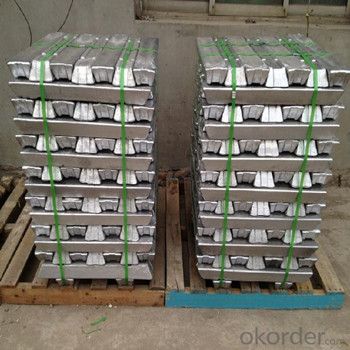

4.Aluminum Pig/Ingot Specification
Grade | Chemical Composition % | |||||||||
Al≥ | impurities ≤ | |||||||||
Si | Fe | Cu | Ga | Mg | Zn | Mn | others | Sum | ||
Al99.9 | 99.90 | 0.50 | 0.07 | 0.005 | 0.02 | 0.01 | 0.025 | - | 0.010 | 0.10 |
Al99.85 | 99.85 | 0.80 | 0.12 | 0.005 | 0.03 | 0.02 | 0.030 | - | 0.015 | 0.15 |
Al99.7 | 99.70 | 0.10 | 0.20 | 0.010 | 0.03 | 0.02 | 0.030 | - | 0.030 | 0.30 |
Al99.6 | 99.60 | 0.16 | 0.25 | 0.010 | 0.03 | 0.03 | 0.030 | - | 0.030 | 0.40 |
Al99.5 | 99.50 | 0.22 | 0.30 | 0.020 | 0.03 | 0.05 | 0.050 | - | 0.030 | 0.50 |
Al99.00 | 99.00 | 0.42 | 0.50 | 0.020 | 0.03 | 0.05 | 0.050 | - | 0.050 | 1.00 |
5.FAQ of Aluminum Pig/Ingot
We have organized several common questions for our clients,may help you sincerely:
①How about your company?
A professional manufacturers of the alumiun pig.Devoted in this industry for many years,so got much experice.The quality and service have also accepted by customer.Can meet customers' requiements to provide different grade and purity alumiun pig.
②How to guarantee the quality of the products?
We have established the international advanced quality management system,every link from raw material to final product we have strict quality test;We resolutely put an end to unqualified products flowing into the market. At the same time, we will provide necessary follow-up service assurance.
③How long can we receive the prod rking days, We will arrange the factory delivery as soon as possible. The pecific time of receiving is related to the state and position of customers.Commonly 7 to 10 working days can be served.
- Q:What are the different heat treatment processes for aluminum ingots?
- There are several different heat treatment processes that can be applied to aluminum ingots to enhance their mechanical properties and overall performance. These processes include: 1. Annealing: This process involves heating the aluminum ingot to a specific temperature and then slowly cooling it down. Annealing helps to relieve internal stresses, improve ductility, and enhance machinability. 2. Solutionizing: Solutionizing, also known as homogenization, is a heat treatment process that involves heating the aluminum ingot to a high temperature to dissolve any precipitates or impurities. This process helps to create a more uniform microstructure and improve the alloy's mechanical properties. 3. Quenching: Quenching is a rapid cooling process that follows solutionizing. It involves immersing the aluminum ingot in a quenching medium, such as water or oil, to cool it down quickly. This process helps to lock in the desired microstructure and improve the alloy's strength and hardness. 4. Aging: Aging is a heat treatment process that follows solutionizing and quenching. It involves heating the aluminum ingot at a moderate temperature for a specific duration to allow for the precipitation of strengthening phases. Aging enhances the alloy's strength, hardness, and resistance to wear and corrosion. 5. Precipitation hardening: Precipitation hardening, also known as age hardening, is a combination of solutionizing, quenching, and aging. It involves heating the aluminum ingot to a high temperature to dissolve any precipitates, followed by rapid cooling and then aging at a lower temperature. This process helps to create a fine dispersion of precipitates within the alloy, resulting in improved strength and hardness. Overall, these heat treatment processes for aluminum ingots offer a range of benefits, including improved mechanical properties, enhanced machinability, and increased resistance to wear and corrosion. The specific treatment process used depends on the desired properties and application of the aluminum alloy.
- Q:What are the dimensions of a typical aluminum ingot?
- The dimensions of a typical aluminum ingot vary, but they are commonly rectangular in shape and can measure approximately 20 inches long, 6 inches wide, and 3 inches thick. However, these dimensions can vary depending on the specific requirements and standards of the industry.
- Q:What is the melting point of aluminum ingots?
- The melting point of aluminum ingots is approximately 660 degrees Celsius or 1220 degrees Fahrenheit.
- Q:How can I make a pop top aluminum ingot?
- For some alloy smelting: some fan casting enterprises Aluminum Alloy in the smelting process, the need to add some pure aluminum components adjustment, but tend to increase the content of magnesium alloy, magnesium alloy in the way of high production more practical;
- Q:How are aluminum ingots used in the production of kitchen utensils?
- Aluminum ingots are used in the production of kitchen utensils as they are melted down and cast into molds to create the desired shape and structure of the utensils. The molten aluminum is poured into the molds, which are then cooled and solidified to form the utensils. This process allows for the production of lightweight, durable, and heat-conductive kitchen utensils that are commonly used in cooking and food preparation.
- Q:How do aluminum ingots contribute to the overall aluminum industry?
- Aluminum ingots play a crucial role in the overall aluminum industry as they serve as the primary raw material for the production of various aluminum products. Ingots are formed by smelting aluminum ore and then pouring the molten metal into molds to solidify. One significant contribution of aluminum ingots is their versatility. They can be further processed and shaped into different forms, such as sheets, plates, rods, tubes, and extrusions, which are used in a wide range of industries. These include automotive, aerospace, construction, packaging, electrical, and consumer goods sectors. Furthermore, aluminum ingots offer several advantages that contribute to the growth and sustainability of the aluminum industry. Aluminum is lightweight, corrosion-resistant, and possesses excellent conductivity, making it an ideal choice for many applications. Its low density allows for energy efficiency in transportation, reducing fuel consumption and emissions in the automotive and aviation sectors. Additionally, aluminum's corrosion resistance ensures longer-lasting products, reducing maintenance and replacement costs. The availability and affordability of aluminum ingots also contribute to the overall aluminum industry. Aluminum is the third most abundant element on Earth's crust and can be easily extracted from bauxite ore. This accessibility, combined with efficient production processes, makes aluminum ingots readily available for manufacturers at competitive prices, stimulating demand and market growth. Moreover, the recycling potential of aluminum ingots plays a significant role in the sustainability of the aluminum industry. Aluminum is infinitely recyclable, meaning it can be melted and reused without any loss in quality. Recycling aluminum requires only a fraction of the energy compared to primary production, resulting in significant energy savings and reduced environmental impact. The use of recycled aluminum ingots helps in conserving natural resources, reducing waste, and lowering carbon emissions. In conclusion, aluminum ingots are essential to the overall aluminum industry as they provide the raw material that is processed into a wide variety of aluminum products. Their versatility, lightweight nature, corrosion resistance, and recyclability make them highly valuable for multiple industries. The availability and affordability of aluminum ingots further contribute to the growth and sustainability of the aluminum industry, while their recycling potential helps in conserving resources and reducing environmental impact.
- Q:It can be dissolved aluminum cans, aluminum ingots, need what equipment?
- A lot of cans are iron, not much aluminum.
- Q:I would like to ask, aluminum water poured into the mold, what should pay attention to? Aluminum solidification in the mold after the aluminum ingot, how can I get it out?
- One side of the mold is generally provided with a push plate, and the two modules are connected by hinges, and the other end is provided with a clip to prevent the aluminum water from expanding into the cavity.
- Q:What are the main factors influencing the choice between aluminum ingots and aluminum slabs?
- The main factors influencing the choice between aluminum ingots and aluminum slabs include the specific application requirements, production processes, cost considerations, and transportation logistics.
- Q:What kinds of aluminum alloy material are used in casting?
- The surface quality of aluminum profile is also difficult to overcome: warping, deformation, black lines, concave convex and white lines. Designers with high levels and reasonable mold design and production process can avoid the defects are not obvious. Inspection defects shall be carried out in accordance with national inspection methods, that is, sight distance 40~50CM to discriminate defects.
1. Manufacturer Overview |
|
|---|---|
| Location | |
| Year Established | |
| Annual Output Value | |
| Main Markets | |
| Company Certifications | |
2. Manufacturer Certificates |
|
|---|---|
| a) Certification Name | |
| Range | |
| Reference | |
| Validity Period | |
3. Manufacturer Capability |
|
|---|---|
| a)Trade Capacity | |
| Nearest Port | |
| Export Percentage | |
| No.of Employees in Trade Department | |
| Language Spoken: | |
| b)Factory Information | |
| Factory Size: | |
| No. of Production Lines | |
| Contract Manufacturing | |
| Product Price Range | |
Send your message to us
Aluminum Pig/Ingot With Good Quality And Wholesale Price
- Loading Port:
- China main port
- Payment Terms:
- TT OR LC
- Min Order Qty:
- 1000 m.t.
- Supply Capability:
- 100000 m.t./month
OKorder Service Pledge
OKorder Financial Service
Similar products
New products
Hot products
Hot Searches







